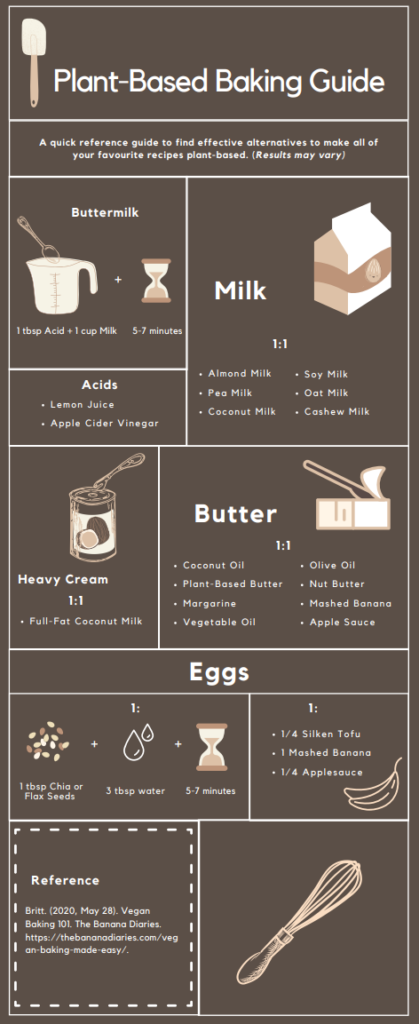
Learning Outcomes:
- By the end of this topic you should be able to:
- Understand and describe the 3 main reasons for why there are limited plant-based alternatives at bakeries.
- Understand and communicate the health benefits of plant-based alternatives in baking.
- Identify and describe a variety of plant-based alternatives in baking, including eggs, milk, cream, and butter.
- Plan and integrate plant-based baking knowledge into home baking by converting recipes with appropriate alternatives.

Introduction
We have often found ourselves discussing our shared passion of baking, which inspired us to create a podcast for this assignment. This lesson will demystify plant-based baking and provide practical tools for the audience to incorporate in their own baking at home. Additionally, it will explain what health-benefits plant-based diets provide and why most food retailers do not carry plant-based goods.
Design Processes
The project was initiated with a research phase, however we soon realized we wanted to apply the dual-coding theory into our lesson. Therefore, we decided to make an additional infographic guide, presentation, and interactive quiz to help support the effectiveness of information transfer from the podcast. The applications we used to create the original multimedia elements included Canva, Google Slides, Kahoot, and a Google Chrome extension called Screenio.
Discussion:
As for theories we followed for this project, we focused on the Dual-Code theory mainly as we provide multiple channels of information transfer through audible and visual representation. We also focused on following the Cognitive Load Theory, where we ensured that in the presentation we kept each slide to one topic and had a maximum of 6 objects to chunk the information on each slide.
Infographic
The infographic was designed to be used as a guide for learners to reference throughout the duration of the lesson and to have afterwards. It directly follows the coherence principle by reducing the information to images and symbols. The infographic is a guide that allows learners to make connections through the placement of text and images, it therefore follows the Multimedia and Spatial Contiguity Principles. The Signalling Principle has been applied as each topic is highlighted by images, titles, and dividers.
Presentation
For the presentation we closely followed the principles of modality and multimedia by trying to keep as minimal information on each slide as we could while providing extra narration to further our points. Additionally, our presentation aims to adhere to the segmenting principle through “chunking” the information we are presenting on each slide so it is easier to digest. The animation principle was also applied here as we relied on static images and screens rather than using animations to keep the focus on the information we are presenting.
Kahoot
We incorporated a game of kahoot into our blog post to test the users understanding of the concept we presented in a fun manner. While not enforcing the game-based learning approach we learned about in previous weeks, we still wanted to incorporate a way where the viewer is able to play around and test their understanding of what they just learned through a fun quiz.
Podcast
Part of the intrigue for learning through podcasts is from the casual delivery in the form of a conversation between peers. This aligns with the Personalization Principle as the concepts are casually discussed instead of a formal presentation delivery. An example of this is how the podcast flows with comments and questions from each party, which demonstrates the realistic conversation aspect and expertise in the subject.
Pitfalls
One of the pitfalls that we encountered was not following our initial plan of a podcast since it would not meet a variety of the multimedia principles. This was because only providing the information through an auditory format would hinder the effectiveness of the lesson. Unfortunately, this design choice caused a repetition of a majority of the content. Since the content to meet the learning objectives was displayed through multiple facets, we had to sacrifice meeting the Redundancy Principle.
Conclusion
To develop a lesson optimized to teach learners about the benefits and practical skills for plant-based baking, we applied numerous multimedia theories and principles in all elements. Through these elements we aimed to provide the listeners with an experience which was not only engaging but effective for information retention. A successful participant should be able to use the tools provided to understand what hinders plant-based options from being available and how they can make their own. This can be measured by the the amount of participants who were inspired after to use the replacements or to explore more plant-based foods.
https://create.kahoot.it/share/plant-based-alternatives-game/94a01992-c1e1-488f-a9f4-20a644c71904
References
Britt. (2020, May 28). Vegan Baking 101. The Banana Diaries. https://thebananadiaries.com/vegan-baking-made-easy/.
Plant-based Protein: Baking Ingredients. BAKERpedia. (2021, January 13). https://bakerpedia.com/ingredients/plant-based-protein/.
MD Anderson Cancer Center, & Alexander, H. (2020, November 4). 5 benefits of a plant-based diet. MD Anderson Cancer Center. https://www.mdanderson.org/publications/focused-on-health/5-benefits-of-a-plant-based-diet.h20-1592991.html.
Mayer, R. (Ed.). (2014). The Cambridge Handbook of Multimedia Learning (2nd ed., Cambridge Handbooks in Psychology). Cambridge: Cambridge University Press. doi:10.1017/CBO9781139547369
Mayer, Richard E., and Logan Fiorella. “Principles for Reducing Extraneous Processing in Multimedia Learning: Coherence, Signaling, Redundancy, Spatial Contiguity, and Temporal Contiguity Principles.” The Cambridge Handbook of Multimedia Learning.Ed. Richard E. Mayer. Cambridge: Cambridge UP, 2014. 279-315. Print. Cambridge Handbooks in Psychology.
Yuen, J. (2020). Person Holding Stainless Steel Fork. Unsplash. https://unsplash.com/photos/pHCazCPGvPw.

Leave a Reply
You must be logged in to post a comment.